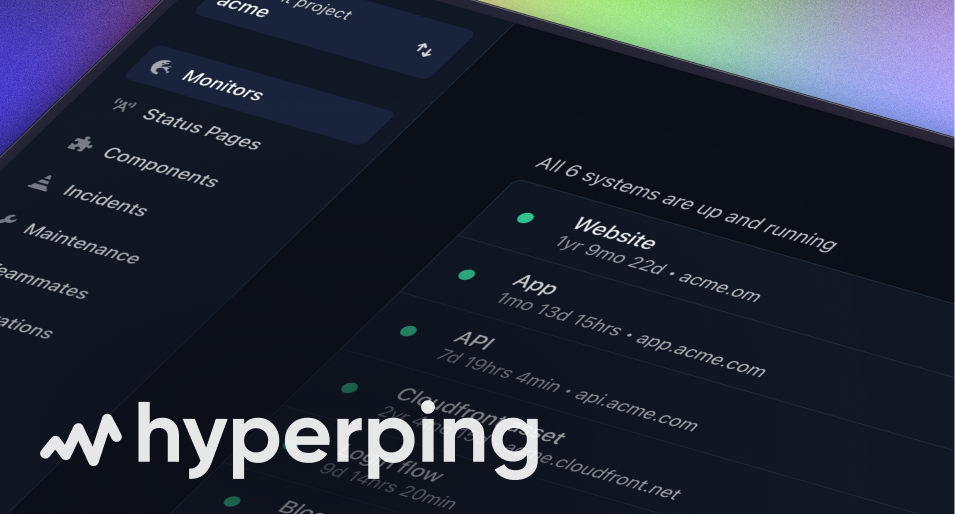Businesses rely on software solutions increasingly in our modern age, and it’s constantly evolving. Compared to some of the software being used in the early 2000s, we’ve seen large changes, resulting in more complex frameworks, which come with their own unique changes.
As software and systems become more complex, so increases the probability of errors occurring and the level of jeopardy those errors might present. Nowadays, software maintenance is crucial and takes up a significant portion of a project's budget, with 90% of it allocated to maintenance.
In this article, we will discuss the most significant challenges in software maintenance today and introduce you to some of the tools (like Hyperping) available to help you overcome them.
Let’s jump right in.
What Is Software Maintenance?
Software maintenance involves modifying and updating software applications after they have been deployed so they remain capable of meeting the requirements of users and the business.
This includes tasks like:
- Fixing bugs
- Adding new features and functionality
- Improving performance
- Updating security features
- Altering & improving usability
Software maintenance is a necessary aspect of the software development lifecycle. Without effective maintenance, the software can eventually degrade (leading to downtime and lost productivity), become increasingly vulnerable to outside threats, and at worst, become obsolete.
Effective software maintenance requires continual attention and investment, as well as collaboration between developers, stakeholders, and end-users.
4 Types of Software Maintenance

Corrective Software Maintenance
Corrective software maintenance involves fixing errors, bugs, or defects in the software that are discovered after its initial release. Corrective maintenance usually begins with bug reports raised by users or through synthetic monitoring and automated bug testing. The goal is to restore the software to its normal functionality as quickly as possible.
Adaptive Software Maintenance
Adaptive software maintenance is the process of altering software to accommodate changes in its environment, such as adjustments to the operating system or changes to hardware. The goal of adaptive maintenance is to ensure that the software stays compatible with its operating environment after changes have been implemented.
Perfective Software Maintenance
Perfective software maintenance refers to improving the software's functionality or performance to meet evolving user needs or to increase efficiency and performance generally. The goal is to enhance the software's usability and overall quality.
Preventive Software Maintenance
Preventive software maintenance is a form of uptime monitoring that involves making changes to the software to preempt potential future problems from occurring.
Preventive maintenance aims to proactively address possible issues like software deterioration or failure. This ensures that the software and its systems remain robust and functional despite any gradual decline in their performance or functionality.
Why Is Software Maintenance Important?
Bug-Free Software
As we’ve already touched upon, throughout the lifecycle of a piece of software, it is likely to encounter bugs and errors that were not found during the development process.
Regular software maintenance can help identify and fix these bugs, ensuring that the software works as it is supposed to.
Removes Obsolete Functions
Software is never static—it’s a continuously evolving system. As a result, programs and applications eventually become inefficient or unfit for purpose.
When that happens, you need to take action by removing obsolete features and functions. Regular software maintenance can help you identify these issues before they become a problem, allowing you to keep your systems up-to-date and running as efficiently as possible.
Performance Improvement
Regular software maintenance is a fundamental part of improving software performance. By staying ahead of any errors and quickly identifying issues like code corruption, you can take the steps required to ensure that the system and environment are performing optimally.
How To Optimize Software Maintenance
Software maintenance is always going to be a key issue for any modern business.
In addition to software requiring maintenance, there are other reasons why software might need to be modified or replaced that can come as a result of numerous business drivers including:
- Market Conditions: The demand for features and use cases can fluctuate dramatically—just look at the number of tools that have added chatbot features in the wake of ChatGPT!
- Client Requirements: The needs of customers frequently change—this can also necessitate new features or functions.
- Host Modifications: Changes to the hardware or platform (e.g., operating system) of the target host require software updates to ensure viability.
- Organizational Changes: When clients make organizational changes, be it downsizing their team, acquiring another company, or venturing into a new business, modifications to the original software may become necessary to accommodate the evolving needs of the organization.
Set your Goals and Objectives
Setting clear goals and objectives is critical for effective software maintenance. It helps to ensure that maintenance efforts are:
- Correctly focused
- Properly prioritized
- Measurable against KPIs and other success metrics
- Aligned with business objectives
- Assigned to stakeholders accountable for performance
Some of the goals to focus on when implementing software maintenance include:
- Enhancing software quality
- Improving security standards and capabilities
- Increasing user satisfaction
- Extending the life of the software
- Achieving cost savings
Use Tools to Automate the Processes
Having the right tools in place goes a long way to ensuring that your efforts at software maintenance are as efficient and effective as possible.
Hyperping is an uptime monitoring tool with comprehensive automation features that monitors your core HTTP services, provides instant alerts for any bugs, issues, or unexpected downtime, and allows you to perform health checks on your system.

Sign up today and see how Hyperping can take your software maintenance to the next level.
Create a Maintenance Plan
You should incorporate maintenance into the software development process from the start.
This requires you to develop a maintenance plan that includes the different types of maintenance likely to be needed, the frequency of maintenance tasks, and identifying who will be responsible for each.
Not all software maintenance is about fixing bugs after release, contrary to the beliefs of many. A strong development plan that incorporates ongoing maintenance should eliminate the majority of issues or bugs before the final release of the software.
Execute the Plan
Notwithstanding the unique nature of each company or team’s maintenance requirements, the software maintenance process generally includes the following steps:
- Identification: The first step in any software maintenance is to identify the issue(s). Normally this occurs with developers, end-users, or through monitoring tools like Hyperping.
- Analysis: Following Identification comes the process of analyzing the issues that have been identified and any solutions that might have been proposed to fix them. Any analysis will include the likely impact of proposed fixes and any costs incurred to get them done.
- Design: Following the determination of the preferred solution, it must then be designed before being implemented. A rigorous design process will ensure the solution meets all key specifications and won’t place any unnecessary burden on the system or the budget.
- Implementation: The roll-out of the new software will often present an opportunity to identify any bugs or issues not addressed in the design stage. Implementation should be seen as another step in the maintenance lifecycle, rather than the end of it.
- System testing: The entire software system must be tested to ensure proper performance after the new software has been implemented. All changes should be independently tested in addition to the entire system as a whole.
- User testing: User testing is the final step in the process. It’s meant to find any issues with the changes before they go live that might have been missed at earlier stages in the process.
- Deployment: Now comes the time for the final deployment, where the changes are delivered to the public through updates. This step concludes the software maintenance process, but as we have been at pains to point out, maintenance and support never truly end until the software is decommissioned.
Document and Assess Results
Proper documentation is crucial for maintaining software. Without taking the time to learn from past mistakes, we risk repeating them again… and again. So, it's important to document everything—from coding issues and failed solutions to the successful solutions that worked and the reasons why. This is an ongoing process, but it's one of the best ways to ensure a smooth software maintenance process for years to come.
After documenting everything, it's time to assess the results. This is part of the quality assurance process, which provides ongoing insight into software performance and allows us to take immediate action if further issues arise. The main metrics typically analyzed for software maintenance include:
- Planned maintenance percentage (PPC)
- Mean time to repair (MTTR)
- Overall equipment effectiveness (OEE)
- Mean time between failure (MTBF)
- Preventive maintenance compliance (PMC)
Upgrade Your Software Maintenance Stack With Hyperping
To keep your software up-to-date with current market demands, and technological developments it's important to constantly improve it.
Tools like Hyperping can streamline the maintenance process by providing detailed uptime monitoring and reports, as well as immediate alerts to key stakeholders through beautiful, interactive status pages.
Give Hyperping a try and see what it can do!




